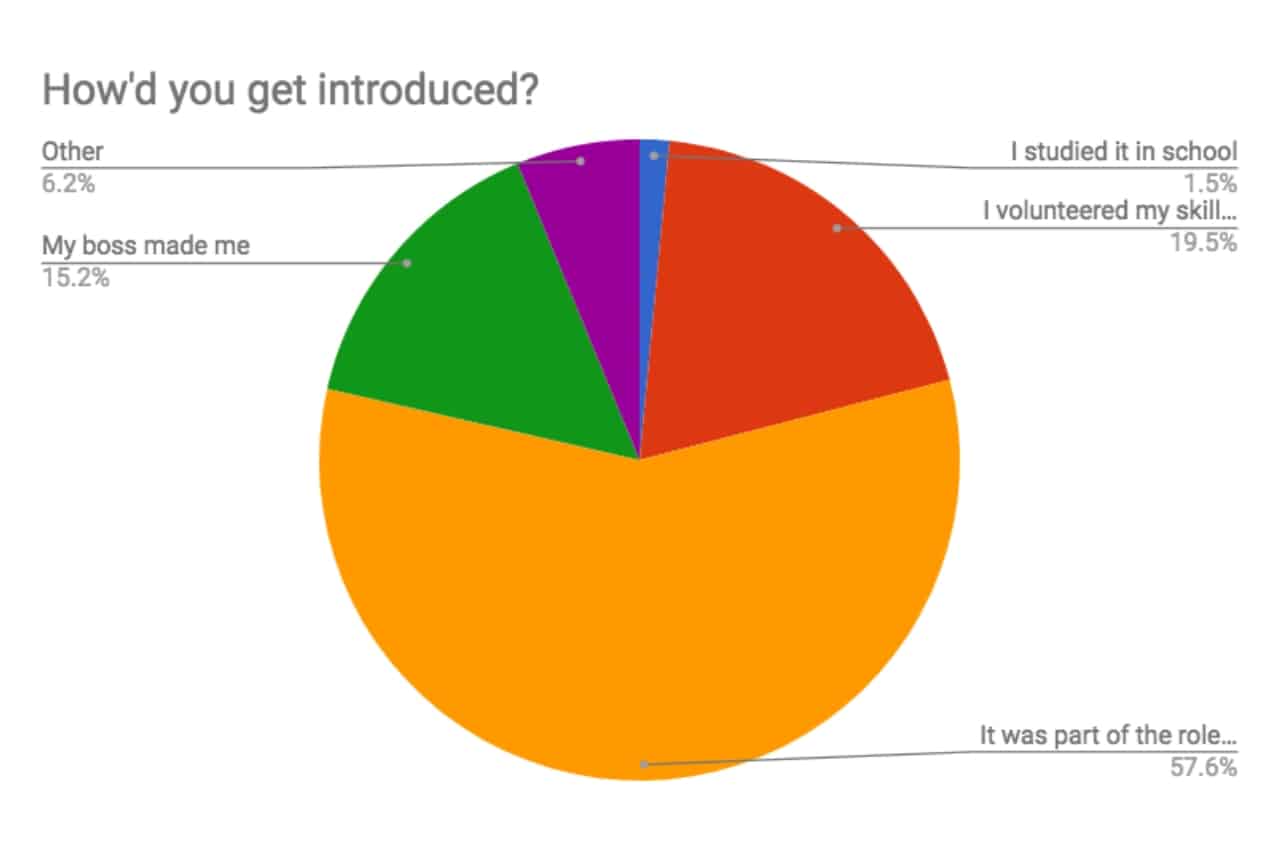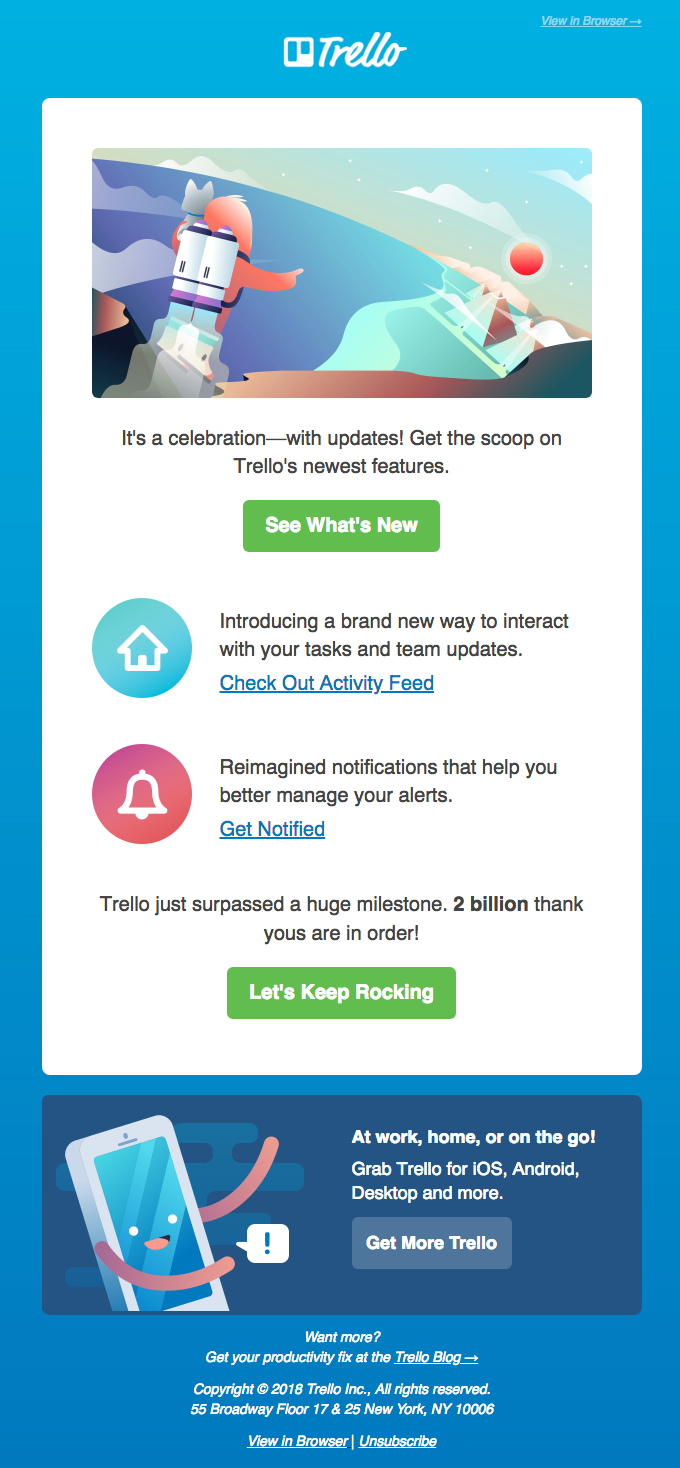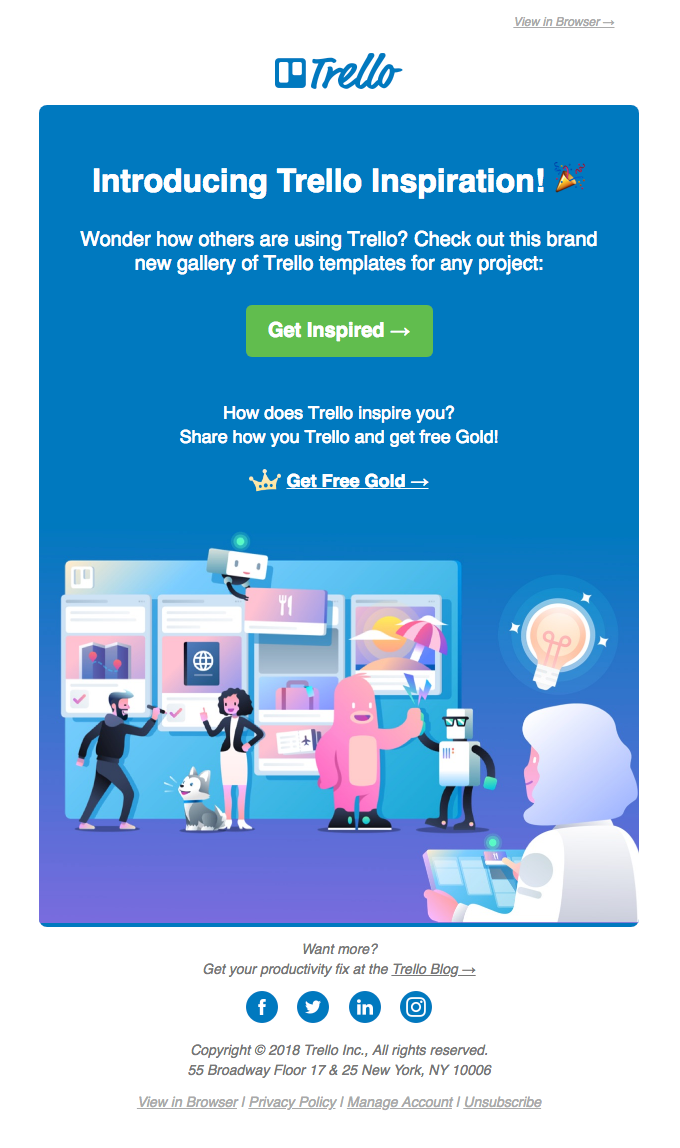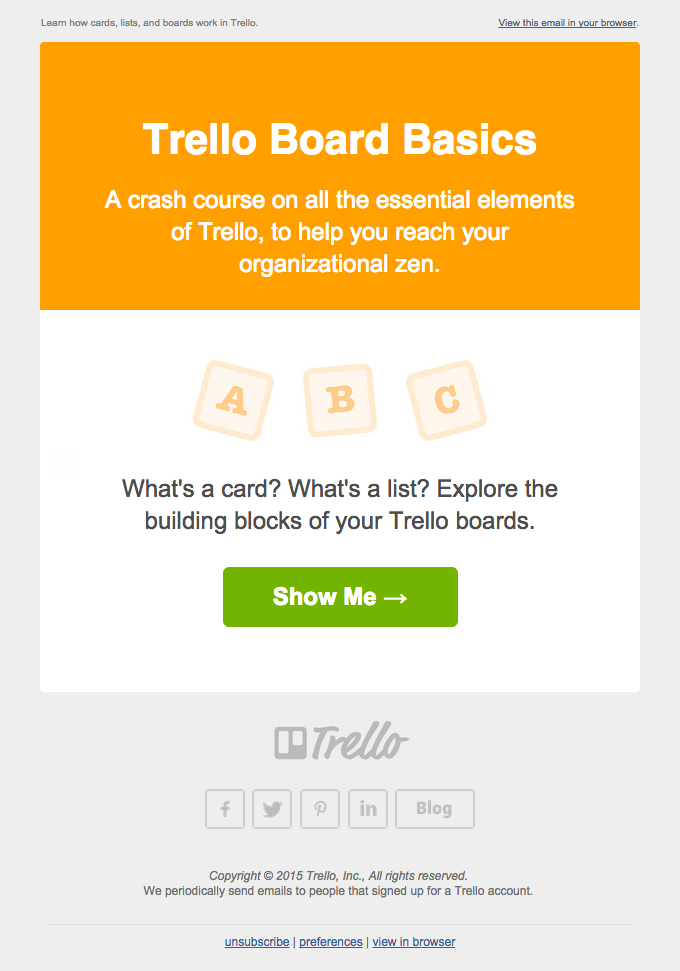
2018 Email Industry Conditions
Wondering what is going on in Email? We surveyed thousands of people in email to get their outlook, skills, teams, history, and strategies.
September 17th, 2018
An interview with Chris Kaundart, Trello’s Email Marketing Manager, about how he handles the email for a large brand by himself and all that entails.

As a sleek tool for streamlining productivity, Trello is hard to beat. But what they also do well (and what’s most important for our purposes), is send clean, efficient emails that look pretty and do good work. And, as is the case for so many of you brave souls out there, it’s a small team making big email magic.
In our State of Email Survey last year, we learned that at least a quarter of y’all are flying solo on the email jet stream. And that’s true for Trello, too. Chris Kaundart is the man behind the emails at Trello, and we chatted with him about how he manages as a team of one, what his QA process looks like, and what he’s learned about email strategies for product engagement.
One of the big ones is to drive a lot of traffic to our blog. We have a content team that does great work on the blog. Most of our content is very productivity focused (a lot of it’s not even about Trello specifically), but we use our newsletters to serve up blog content. We also focus on just encouraging use of the Trello product.
Since I’ve started, I’ve worked to simplify our newsletter in some ways — it’s pretty good looking now. Our designers did a great job, and we stripped away some of the design elements on it, and just keeping things simple has helped a lot.

One of the older newsletters had this huge graphic on the top. And it was this thing where one of our marketing team members would spend like an hour just making this graphic every week. We ran a test, and in a version we sent that didn’t include it, the conversion rate was close to 5% higher. So, it saves her a couple hours a week and helped us focus on the content side. We do a lot of things like that — CTA testing, etc.
I was kind of surprised by a test we ran recently where we tested a CTA as a link versus a button, and the link actually did better. I was expecting the button to do better, but the link had a significantly higher click through rate.
We did a lot of testing of our old newsletter to try to figure out what works and what doesn’t. And one of our designers who has a knack for email marketing (Samantha Gobert), she tried to come up with a new beautiful design that jumps straight into the content since that was one of our big lessons — that reducing the clutter at the top improves click rate.
So, we did a lot of brainstorming as a team and looking for what looked good (we thank Really Good Emails for inspiration on that!). We collected examples of things that looked good and modern, but we also didn’t want to just follow trends, too. A lot of people are doing white background emails, that’s very popular, so we wanted to be a little different. So, she figured out a way to add a cool background gradient. It actually works in Outlook, too!

I’m a team of one who also draws on work from people on a number of other teams to put our emails together. I’ve mentioned Samantha Gobert (one of our Marketing Designers), but I also get amazing help from Lauren Moon (one of our Senior Content Marketing Managers), Jessica Webb (one of our Product Marketing Managers), and Lexy Greenwell (one of our Marketing Analysts).
The process is generally that we get a layout or template that works and then don’t really deviate from that for a good chunk of time — as it’s costly for me to update design on emails every week, so it’s not very practical for me to do that. So we focus a lot on lifecycle things — we want to look at user experience and figure out what works and set that in place. In terms of newsletter, my colleague Lauren will look at what’s been doing really well on our blog and pick the content to feature in our newsletter, and I’ll do the set up and prep. But we don’t do unique design updates because that’s not cost-effective for us as a small team.
The build-out usually take a week or so — if we have a newsletter next week, this week on Monday or Tuesday, she’ll pick the articles she wants to include. Then we’ll go back and forth with the team on the copy, and by the end of the day Friday, the email is almost done — so usually 4–5 days.
Of course we do! We don’t do a lot of the things retail companies might — like promotions and things that would need to go on a calendar. We generally send a newsletter twice a month, so there’s a relatively fixed timeline. Say for example, the newsletter goes out on Wednesday, work starts the week before.
We’ll use a card on our Content Team’s board to solicit feedback, discuss relevant details on the email, and get approval from the right people.

After we’ve settled on all the copy and the email is ready to go, we have it set up in our ESP and send proofs to the team. The team uses a checklist to check everything off. After that, I will look at it as part of that review process and as part of the set-up process. Then I’ll take a step away from it for a period of time and come back with a clear frame of mind and double check. I also tend to be kind of paranoid, so usually the morning of, I’ll go through it one more time with our checklist. It’s common for me to QA an email 3–5 times, in addition to my teammates checking it as well.
I never enjoy telling anyone no. But seeing how the opportunity cost of me working on an email is pretty big (I can only work on one thing at a time), it forces me to be more selective with how I spend my time.
Generally, I’ve tried to put some friction in our email request process. If someone wants to email our users, I ask the requester to justify why it will benefit them. Emailing our users is a privilege, and it’s one I take really seriously.
The key to all of this, though, is clear, honest, and upfront communication. On our request board, I clearly lay out how I prioritize requests and what we will or won’t do. It seems to work fairly well — we’ve found a great balance.
When possible, we try to naturally align our emails with bigger things that may be happening. Since we’re a productivity tool, we’ll do something bigger than usual come January to align with New Year’s Resolutions and things like that. When it makes sense, we align our product with something more seasonal that may be going on. If a major event that may be going on — like Atlassian’s summit last year, we had a big product announcement as part of that.
That’s one where we’re still trying to crack the formula. One thing we try to look at is if someone signs up for Trello in a given week, do they come back the week after? We try to measure that, as it indicates if someone is getting value out of Trello. Then I also just go off of click-through and open rates — are people actually accessing the content via email.
We’re still developing our deeper engagement metrics around email, but we’re really looking into things like return rate (weekly, monthly) to see if our emails are helping users find value in Trello.

One thing we don’t do is we never look at someone’s content in their Trello boards or account — so we don’t have a great read on what people are using Trello for. So, segmenting has been a particular challenge. We’re exploring other ways to learn about our users like soliciting feedback and exploring some segmentation around their interactions with our emails.
The biggest change in our newsletter was the new design, and it simplified things in a lot of ways and let us focus on getting the right content in there. So, our readers are definitely clicking on it more, so I take that as a sign that we’re getting more of the content they wanted in the newsletter.
I really think that even though we have this beautiful design that has some complex things in it (like the gradient in the background), I think the biggest thing is that it’s simpler. I’m just laser focused on making it easier. When I work on an email, I just want it to be as easy as possible for the reader to consume. The actual metric might be click rate, but I frame this internally as our content was easier to consume.
This may not seem that big, but I never thought emojis would work in subject lines. I just didn’t see it… I thought it was too unprofessional, but it works.
Don’t think about yourself when you do it. Think about what benefits your subscribers. What do they want your email to do for them? Put yourself in their shoes and think about what they really want. If you do that, you probably won’t need to worry about deliverability or really poor engagement with that. Your click rate will be better because you’re doing what they want.
There’s an email newsletter called Morning Brew that I’ve really been enjoying. I’m trying to wean myself off of a lot of social media and content with an agenda. So, there’s two email newsletters that provide me with great information without all the noise of quick reactions. Morning Brew and Axios — which offer news with a very neutral political view.
Categories:
Case StudiesDive into the world of unmatched copywriting mastery, handpicked articles, and insider tips & tricks that elevate your writing game. Subscribe now for your weekly dose of inspiration and expertise.